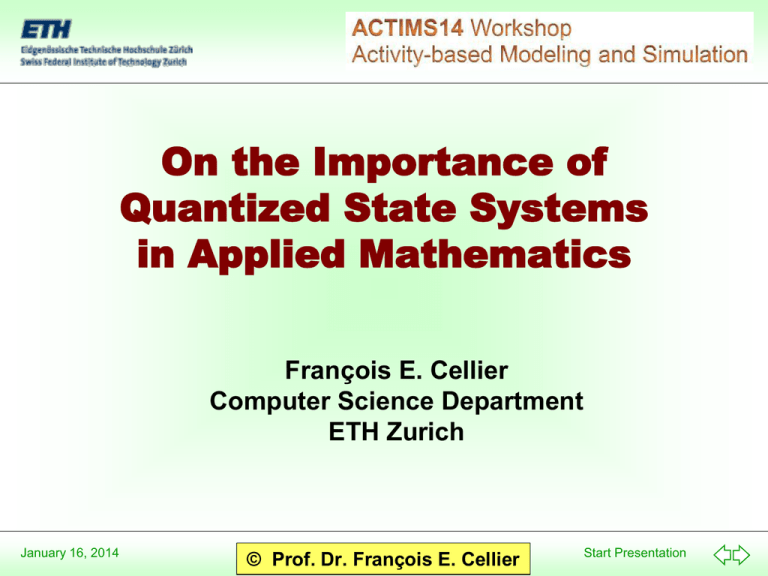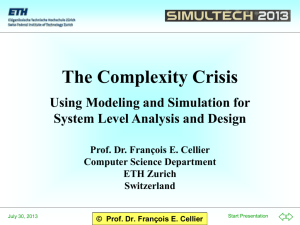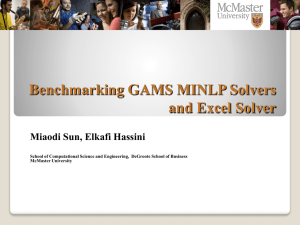(QSS) Solvers - Spatial Computing
advertisement

On the Importance of Quantized State Systems in Applied Mathematics François E. Cellier Computer Science Department ETH Zurich January 16, 2014 © Prof. Dr. François E. Cellier Start Presentation History of Physical System Simulation I • In the early days of digital physical system simulation (1955-1990), simulation software, such as ACSL, employed mostly explicit ODE solvers as their default algorithms. • These allowed for a clean separation between model and solver equations. • Models to be simulated were usually of low order; they were therefore rarely stiff, and a forth-order Runge-Kutta algorithm was appropriate for most applications. • In case a model turned out to be stiff nevertheless, a stiff system solver was offered as an alternative. January 16, 2014 © Prof. Dr. François E. Cellier Start Presentation The Importance of Higher Order Solvers • To achieve high accuracy, low-order algorithms turn out to be very expensive. • As a rule of thumb, in order to achieve n digits of accuracy, an nth order algorithm should be employed. • As simulations of engineering systems usually call for 3-4 digits accuracy, a 3rd or 4th order algorithm is appropriate. January 16, 2014 © Prof. Dr. François E. Cellier Start Presentation Lessons to be Learned I • Never compare your favorite ODE solver against a Forward or Backward Euler algorithm. • These are first-order accurate algorithms only, and therefore, they are not useful for any practical purposes. They are toy algorithms, only useful for introducing the concept of numerical simulation to students during the first lecture on that topic. • If you compare your own algorithm against Euler, you are automatically and instantaneously discrediting your work. January 16, 2014 © Prof. Dr. François E. Cellier Start Presentation The Analytical Stability • A linear system is analytically stable if and only if all of its eigenvalues have negative real parts. • A non-linear system is analytically stable if all eigenvalues of its linear part (the Jacobian matrix) have negative real parts. January 16, 2014 © Prof. Dr. François E. Cellier Start Presentation The Numerical Stability Domain I • Every numerical ODE solver has a numerical stability domain in the l·h plane. • All eigenvalues of the Jacobian matrix, l, multiplied by the step size, h, must lie inside the numerically stable region in order to achieve a numerically stable simulation. • “Fast” eigenvalues (eigenvalues far out to the left) require a small step size to achieve a numerically stable simulation. January 16, 2014 © Prof. Dr. François E. Cellier Start Presentation Stiff Systems • Stiff systems are characterized by fast and slow eigenvalues of their Jacobian matrices. • The slow eigenvalues determine the length of the simulation, whereas the fast eigenvalues determine the step size. • Stiff systems call for very many steps, i.e., lead to a slow simulation when simulated using a Runge-Kutta algorithm. • All explicit ODE solvers have stability domains similar to those of the Runge-Kutta algorithms. • Explicit ODE solvers can never be efficient stiff system solvers. January 16, 2014 © Prof. Dr. François E. Cellier Start Presentation History of Physical System Simulation II • Current tools (1990-2010) for the digital simulation of physical systems, such as Modelica, make mostly use of implicit ODE solvers as their default algorithms. • Physical system models to be simulated today usually contain a few dozen state variables. Such models are almost always stiff (electro-mechanical systems exhibit mechanical modes (eigen-frequencies) in the order of 10-100 Hz and electrical modes in the order of 1-10 kHz). • The most widely used implicit ODE solvers on the market today are the backward difference formulae, with DASSL being their most often used implementation. January 16, 2014 © Prof. Dr. François E. Cellier Start Presentation The Numerical Stability Domain II • Some implicit numerical ODE solvers (but not all of them) exhibit numerical stability domains that loop in the right-half l·h plane. • Their simulations are numerically stable (but not necessarily accurate) everywhere except inside the enclosed area. • “Fast” eigenvalues (eigenvalues far out to the left) do not limit the step size for the purpose of achieving numerically stable simulations. January 16, 2014 © Prof. Dr. François E. Cellier Start Presentation Lessons to be Learned II • As the models to be simulated grow in size, they become invariably stiff. • As the numerical stability domains of all explicit solvers loop in the left-half l·h plane, explicit algorithms become ever less useful. • Some (but not all) implicit solvers have numerical stability domains that loop in the right-half l·h plane. These are the algorithms of the future. • Numerical ODE solver research today is almost exclusively in the area of stiff system solvers. January 16, 2014 © Prof. Dr. François E. Cellier Start Presentation Lessons to be Learned III Computational effort Explicit ODE solver Stiff system solver • Model order invariant • Accuracy requirements invariant Increasing stiffness • If your favorite ODE solver is an explicit algorithm, you just missed the party! January 16, 2014 © Prof. Dr. François E. Cellier Start Presentation Implicit ODE Solvers . Model equations: x(t+h) = f(x(t+h)) _. Solver equations: x(t+h) = h·x(t+h) + old(x) • The model and solver equations together form an algebraic loop. • The implicit ODE solver is set up as a Newton iteration around the model and solver equations to solve for the future values of the state vector and state derivative vector simultaneously. The computational effort of the ODE solution grows cubically in the number of state variables, i.e., in the size of the model! January 16, 2014 © Prof. Dr. François E. Cellier Start Presentation The Curse of Complexity Stiff system solver Computational effort Explicit ODE solver • • Stiffness invariant Accuracy requirements invariant Increasing system order • Classical stiff system solvers are not attractive for the simulation of high order systems! January 16, 2014 © Prof. Dr. François E. Cellier Start Presentation Lessons to be Learned IV • Typical stiff engineering models of interest today (that usually consist of a few dozen state variables and a few hundred algebraic variables) can be simulated in Modelica within a few seconds of simulation time using the default DASSL stiff system solver. • Models that are 10 times as big will take hours to simulate. • Models that are 100 times as big will take longer to simulate than the life time of the computer. • The current stiff solver technology does not scale well! January 16, 2014 © Prof. Dr. François E. Cellier Start Presentation Quantized State System (QSS) Solvers • Traditional ODE and DAE solvers make use of time slicing. Given the current and past state and state derivative values, the value of the state one time step into the future, i.e., at time tk+1, is being estimated. At that time, the new state can assume any real-valued number. • QSS solvers operate differently. Rather than discretizing the time axis, they discretize the state axis, i.e., they operate on quantized states. They evaluate the next state value at the first time instant in the future at which the state variable differs from its current value by one quantum level, i.e., when xk+1 = xk ± Dx. QSS solvers are activitybased solvers. • QSS solvers are naturally asynchronous. Each state variable carries its own simulation clock. • As QSS solvers offer dense output, each solver knows the current values of all other neighboring states whenever it undergoes its own internal transition. January 16, 2014 © Prof. Dr. François E. Cellier Start Presentation Quantized State System (QSS) Solvers II January 16, 2014 © Prof. Dr. François E. Cellier Start Presentation Quantized State System (QSS) Solvers III • We were able to complete the simulation in 17 very simple steps, thereby obtaining the exact solution of the quantized system. • The error of the simulation is linear in the chosen quantum, Dq. • This solver is however only firstorder accurate, and consequently, QSS1 must be considered a toy solver. January 16, 2014 © Prof. Dr. François E. Cellier Start Presentation Quantized State System (QSS) Solvers IV January 16, 2014 © Prof. Dr. François E. Cellier Start Presentation Quantized State System (QSS) Solvers V • To avoid illegitimate models, we need to introduce hysteresis. • An nth order physical system model can be simulated in QSS using n static function blocks and n hysteretic integrator blocks. • QSS solvers can be easily implemented using the DEVS formalism. January 16, 2014 © Prof. Dr. François E. Cellier Start Presentation Quantized State System (QSS) Solvers VI • Higher-order QSS methods are obtained by changing the quantizer. • A QSS2 method uses a first-order hold instead of the previously used zero-order hold. • Nothing else needs to change. January 16, 2014 © Prof. Dr. François E. Cellier Start Presentation Quantized State System (QSS) Solvers VII January 16, 2014 © Prof. Dr. François E. Cellier Start Presentation Quantized State System (QSS) Solvers VIII • We observe a high frequency oscillation on q2(t). • QSS1 is an explicit method, and consequently, the method cannot be used effectively as a stiff system solver. • We need an implicit version of a QSS method. January 16, 2014 © Prof. Dr. François E. Cellier Start Presentation Quantized State System (QSS) Solvers IX • We need to change the quantizer once more. • Rather than keeping q(t) constant until x(t) differs from q(t) by Dq, we anticipate whether x(t) is in the process of increasing or decreasing, set q(t) accordingly one Dq higher or lower and wait until x(t) = q(t). • This is now an implicit solver, because we need to anticipate future values of x(t), but we do not need Newton iteration, because there are only two possible outcomes: up or down. January 16, 2014 © Prof. Dr. François E. Cellier Start Presentation Quantized State System (QSS) Solvers X • The high frequency oscillations have been avoided. The simulation terminates after only a few steps. • This method, named LIQSS1 can thus be used as a stiff system solver. • Also LIQSS1 is only first-order accurate and therefore a toy method, but higher orders of approximation accuracy can be obtained in the same way as before, i.e., by replacing the zero order hold (ZOH) by a first-order hold (FOH) or even second-order hold (SOH). January 16, 2014 © Prof. Dr. François E. Cellier Start Presentation Quantized State System (QSS) Solvers XI January 16, 2014 © Prof. Dr. François E. Cellier Start Presentation Quantized State System (QSS) Solvers XII January 16, 2014 © Prof. Dr. François E. Cellier Start Presentation Quantized State System (QSS) Solvers XIII • In QSS1 (and LIQSS1), the effort grows linearly with the accuracy requirements. If I am willing to pay 10 times more for the simulation, I get simulation results that are 10 times as accurate. • In QSS2 (and LIQSS2), the effort grows with the square root of the accuracy requirements. If I am willing to pay 10 times more for the simulation, I get simulation results that are 100 times as accurate. • In QSS3 (and LIQSS3), the effort grows with the cubic root of the accuracy requirements. If I am willing to pay 10 times more for the simulation, I get simulation results that are 1000 times as accurate. • For most engineering applications, a third-order method is good enough. Our toolbox offers however also fourth-order accurate QSS4 and LIQSS4 methods. January 16, 2014 © Prof. Dr. François E. Cellier Start Presentation Quantized State System (QSS) Solvers XIV • Convergence and stability properties for QSS solvers have meanwhile been established. • QSS solvers even offer an advantage in this respect. Whereas traditional solvers only estimate the local integration error within one step, QSS solvers offer an upper bound on the global simulation error across the entire simulation at least for linear systems. • When simulating a small-scale non-stiff model without discontinuities, QSS solvers are slightly less efficient than explicit Runge-Kutta solvers (there is a slightly bigger overhead). These models don’t offer anything that the QSS solvers can exploit. However, such models are not of much interest today, because any solver can deal with them efficiently, and the QSS solvers will not fare much worth than any of the traditional solvers. January 16, 2014 © Prof. Dr. François E. Cellier Start Presentation Quantized State System (QSS) Solvers XV • To demonstrate the performance of the LIQSS family of stiff system solvers, an inverter chain (a simplified model of a transmission line) with a fast load at the end was simulated. Each logical inverter is represented by a second-order system. Thus 500 inverters lead to 1000 differential equations. As the load is fast, the overall system is stiff, and consequently, Dymola (the most advanced among the different Modelica implementations currently on the market) has no choice but to employ a stiff system solver. Of the different stiff system solvers available in Dymola, Esdirk23a turned out most efficient for this simulation. Hence this is what we compared LIQSS against. • We kept the load (i.e., the stiffness) the same, but changed the number of inverters (i.e., the size of the system), and plotted the required simulation time for a given fixed accuracy as a function of the number of inverters in the chain. January 16, 2014 © Prof. Dr. François E. Cellier Start Presentation Quantized State System (QSS) Solvers XVI • The cubic growth of the computational load as a function of the system size for classical (BDF-type) stiff system solvers is clearly visible. • In contrast, the computational load grows only linearly in the number of differential equations for LIQSS solvers. January 16, 2014 © Prof. Dr. François E. Cellier Start Presentation Quantized State System (QSS) Solvers XVII LIQSS simulated this problem almost 1000 times faster than Dymola (using Esdirk23a), and 300 times faster than Matlab (using Ode15s). LIQSS was even almost twice as fast as a multi-rate solver that had been specifically designed for this particular problem (the problem specification was taken from a paper introducing the multi-rate algorithm). January 16, 2014 © Prof. Dr. François E. Cellier Start Presentation Conclusions As the size of the models to be simulated is constantly increasing, we need stiff system solvers that scale well with system size. We need to get away from centralized schemes that employ one big Newton iteration spanning over the entire model. Activity-based LIQSS solvers scale much better with model size than the classical BDF algorithms (such as DASSL) or the implicit RungeKutta solvers (such as Radau IIa). Rather than exhibiting a cubic dependence on the model size, they demonstrate a linear growth in execution time. In this fashion, also large-scale models with hundreds or even thousands of state variables can be simulated within reasonable time. January 16, 2014 © Prof. Dr. François E. Cellier Start Presentation








